抗体噬菌体展示技术
全面解读诺贝尔化学奖之噬菌体展示技术

全面解读诺贝尔化学奖之噬菌体展示技术当2018年诺贝尔化学奖颁布的那一刻,我禁不住高呼一声:今年的三大自然科学奖项都被生物学给“收入囊中”了。
别的不说,就说噬菌体展示技术,经过义翘神州十多年的应用改善,已经成为公司抗体制备技术的主要手段,制备开发的抗体近万种,还有几种抗体药物也在临床试验阶段。
为了让大家对噬菌体展示技术有更加清晰的了解,我结合公司十多年的抗体研发生产经验写了本文,希望给大家带来帮助。
1.噬菌体展示技术的发展进化之路1985年Smith GP利用基因工程,将外源基因插入丝状噬菌体(Filamentous bacteriophage,fd)的基因组,使目的基因编码的多肽以融合蛋白的形式展示,从而创建了噬菌体展示技术。
1990年,Mc Cafferty等利用噬菌体展示技术构建了库容为106的抗体库,使其成为一种新兴的抗体制备技术。
而Sir Gregory P. Winter是第一个利用噬菌体展示技术将鼠源抗体药物人源化,使得抗体药物用于临床治疗,比如Adalimumab。
噬菌体展示技术创建后就成为了生物学研究中的重要研究手段,从根本上改变了传统单克隆抗体制备流程(杂交瘤技术),被广泛应用于抗原抗体库的建立、药物设计、疫苗研究、病原检测、基因治疗、抗原表位研究及细胞信号转导研究等。
随着技术的不断发展完善,还进化为多种展示技术,如核糖体展示、mRNA展示、细菌展示和酵母展示等。
噬菌体展示技术(phage display)是将外源编码多肽或蛋白质的基因通过基因工程技术插入到噬菌体外壳蛋白结构基因的适当位置,在阅读框能正确表达,使外源多肽或蛋白在噬菌体的衣壳蛋白上形成融合蛋白,随子代噬菌体的重新组装呈现在噬菌体表面,可以保持相对的空间结构和生物活性。
然后利用靶分子,采用合适的淘洗方法,洗去未特异性结合的噬菌体。
再用酸碱或者竞争的分子洗脱下结合的噬菌体,中和后的噬菌体感染大肠杆菌扩增,经过3-5轮的富集,逐步提高可以特异性识别靶分子的噬菌体比例,最终获得识别靶分子的多肽或者蛋白。
噬菌体展示技术和其应用ppt课件

2024/3/30
25
应用举例:
部分做过的工作
2024/3/30
26
一、半合成噬菌体抗体库的构建
构建一个半合成抗体库,不经免疫制备人源抗Tie2 Fab抗体。通过RT-PCR方法,从人脐带血淋巴细胞总 RNA 扩增轻链基因及重链VH段基因,将轻链基因插 入pCOMb3载体中,得人轻链质粒库;从乙肝表面抗 体(HBsAb)的Fd段基因制备含有不同长度随机化 CDR3的FR3-CDR3-J-CH1片段,然后将VH段基因与随 机化的CDR3融合,得到Fd基因片段,再将其插入轻链 质粒库中,得半合成人Fab质粒库。
成3节段
2024/3/30
17
M13噬菌体
丝 状 噬 菌 体
λ噬菌体、T4噬菌体、T7噬菌体
蝌 蚪 形 噬 菌 体
2024/3/30
18
T7与M13相比优势明显
T7Select的优势 解释
是在细胞质中表 达的裂解性噬菌 体
C-端融合
与M13不同,T7是裂解性的,其展示的蛋白无需分泌。
插入序列被克隆到T7Select载体基因10 的C-端,可以使带有终止密码子的 插入子得以表达和展示。
2024/3/30
34人源噬菌体Fab抗体半合成的构建将酶切纯化的重链重叠PCR产M13的超感染 下,繁殖出表算出κ+Fd(包括CDR3-5个菌落,涂格,过夜培养后菌落PCR: 其中6个克隆中有轻链也有重链。双链插入率 为60%左右。
κ 链 文 库 的 容 量 为 5.03×106,λ 链 文 库 的 容 量 为 6.8×106(多次建库混合后的库容量)。
从平板上随机挑取10个菌落,涂为70%。
载体克隆容量大 T7载体比M13克隆容量大,而任何克隆到M13上大于1 kbp的片段都不稳定。
噬菌体展示技术的原理及应用

8、 DNA结合蛋白:
锌指蛋白是一类 DNA 结合小肽结构物,这些结 构含有锌,能用于构建一个大的蛋白区域,去识别 和结合特殊的 DNA 序列。噬菌体展示技术也可以用 于创造一个大的、具有识别不同 DNA 序列的 锌指 的多肽库。利用这个多肽库,可以研究有关氨基酸 序列与 DNA 结合位点之间的识别规则,可以通过设 计 锌指多肽去控制基因的表达,比如抑制小鼠细胞 系中的癌基因,也可以启动表达质粒的基因,或干 扰病毒感染插入的片段是从 某些组织或细胞中抽提的mRNA 的互补DNA 片 段,它用来筛选与受体特异性结合的片段。一般可 利用M13 噬菌体或其他表 达一部分真核蛋白,而M13 噬菌体和其他E. coli噬 菌体所能表达的真核蛋白更少。研究表明,没有一 个展示系统能够表达所有的真核细胞蛋白。无论 如何,噬菌体表面cDNA 库的表达将是研究蛋白质 之间相互作用的有用工具。cDNA 库的噬菌体展 示提供了一个应用免疫学方法进行酶:
例:碱性磷酸酶,蛋白水解酶类,等等
6、底物与抑制剂:
主要是蛋白酶的底物和其抑制剂。
7、信息传递研究:
利用噬菌体展示多肽库,发现了一些受体,如 凝血致活酶、黑皮质素受体、CD80 和一个 Hantaviral 受体;受体的配体, 如血管促生素、 αbungarotoxin, 和一些大蛋白分子中的折叠区域, 如 SH2、SH3 和 WW 区域。从多肽库中可分离 到与天然激素相似的、与受体结合的高亲和力的 多肽, 因此用完整细胞可以从多肽库中找到受体的 高选择性配体。在不知道任何有关的受体和配体 信息的情况下,用完整细胞和组织或动物,可筛 选到特异与靶组织结合的多肽和蛋白。
一、发展简史
Dulbecco等提出了在病毒表面展示外源抗原 决定簇和肽的概念。 1985年Smith — 首次利用基因工程技术将 EcoRⅠ内切酶的部分基因片段(171 bp和132 bp)与 pⅢ基因融合,获得的重组噬菌体可在体外稳定增 生,表达产物能被抗EcoRⅠ内切酶抗体所识别.。 1988年Parmley — 将已知抗原决定簇与噬菌体 PⅢ N端融合呈现在其表面,并提出通过构建随机 肽库可以了解抗体识别的抗原决定簇表位的设想.。 1990年McCafferty — 用噬菌体展示技术筛选 溶菌酶的单链抗体成功使噬菌体展示技术进入一 个广泛应用的时代。
噬菌体展示技术操作步骤

筛选多肽试剂及配制(1)LB培养基:胰蛋白胨10g酵母提取物5gNaCl 5g溶于去离子水,至1L,高压灭菌,4℃保存。
(2)IPTG/Xgal:称取1.25g IPTG,1.0g Xgal,溶于二甲基甲酰胺,至总体积25ml,-20℃避光保存。
(3)LB/IPTG/Xgal平板:1L LB培养基+15g琼脂粉,高压灭菌,冷却至70℃以下,加入1ml IPTG/Xgal,立即铺板,4℃避光保存。
(4)顶层琼脂糖凝胶:胰蛋白胨10g酵母提取物5gNaCl 5gMgCl2.6H2O 1g琼脂糖7g溶于适量去离子水中,至总体积为1L。
高压灭菌,分装为50ml/份,室温保存,使用时于微波炉内融化。
(5)2×M9盐:Na2HPO412gKH2PO46gNaCl 1gNH4Cl 2g溶于适量去离子水中,至终体积为1L。
(6)小型平板:500ml 2×M9盐500ml 3%琼脂粉20ml 20%葡萄糖2ml 1M MgSO40.1ml 1M CaCl21ml 硫胺素(10mg/ml)在混合之前,将上述成分分别高压灭菌并冷却至70℃以下,葡萄糖和硫胺素采用过滤除菌。
平板储存于4℃。
(7)封闭缓冲液:0.1M NaHCO3(PH 8.6)5mg/ml BSA0.02% NaN3过滤除菌,储存于4℃。
(8)TBS:50mM Tris-HCl (PH 7.5)150mM NaCl高压灭菌,室温储存。
(9)PEG/NaCl:20%(w/v)聚乙二醇-80002.5M NaCl高压灭菌,室温储存。
(10)碘化物缓冲液:10mM Tris-HCl (PH 8.0)1mM EDTA4M NaI室温避光保存。
操作步骤:1.第一天(1)以0.1M NaHCO3(PH 8.6)制备 100μg/ml的靶分子溶液。
如果需要稳定靶分子,可以用含有金属离子的相似离子强度缓冲液。
(2)在每孔内加入1.5ml 靶分子溶液,重复涡旋直至表面完全湿润(这一步要多注意,尽量避免溶液形成液珠)。
简述噬菌体展示的基本原理和方法

简述噬菌体展示的基本原理和方法噬菌体展示是一种利用噬菌体(即细菌病毒)作为展示载体来展示外源蛋白的方法。
噬菌体是一种寄生在细菌上并以细菌为宿主的病毒,它具有高效的感染能力和高度选择性的感染靶细菌的特性,因此被广泛应用于基因工程、蛋白质工程和生物技术研究领域。
噬菌体展示的基本原理是将目标蛋白的编码基因与噬菌体的外壳蛋白基因相连接,构建成重组噬菌体基因。
在噬菌体感染细菌的过程中,重组噬菌体基因会被细菌细胞内的转录和翻译系统识别并表达出来,从而使目标蛋白与噬菌体的外壳蛋白相连,展示在噬菌体的表面。
噬菌体展示的方法主要有两种:一种是基于基因III的展示系统,另一种是基于基因VIII的展示系统。
基因III是噬菌体表面的主要外壳蛋白,通过将目标蛋白编码基因与基因III基因相连接,并在细菌细胞内进行表达,可以使目标蛋白与噬菌体的外壳蛋白连接在一起。
基因VIII则是噬菌体的次要外壳蛋白,通过将目标蛋白编码基因与基因VIII基因相连接,并在细菌细胞内进行表达,可以使目标蛋白展示在噬菌体的表面。
噬菌体展示的方法在实验室中可以通过以下步骤来进行:首先,将目标蛋白的编码基因与噬菌体的外壳蛋白基因进行连接,构建成重组噬菌体基因;然后,将重组噬菌体基因导入到感染性大肠杆菌等宿主细菌中;接着,通过培养宿主细菌,使重组噬菌体基因在细菌细胞内进行转录和翻译,从而使目标蛋白与噬菌体的外壳蛋白连接在一起;最后,通过离心分离和纯化的方法,获得展示目标蛋白的重组噬菌体。
噬菌体展示的优势在于其高效、高通量和高度选择性的表达特点。
由于噬菌体具有高效的感染能力和短周期的复制时间,可以在短时间内大量表达目标蛋白,并且可以通过筛选和分离的方法选择性地表达和纯化感兴趣的蛋白。
此外,噬菌体展示还可以实现对目标蛋白的定向进化和筛选,使其具有更好的性能和活性。
噬菌体展示在科学研究和应用领域具有广泛的应用价值。
在药物研发领域,噬菌体展示可以用于筛选和鉴定潜在药物靶点,并可以通过定向进化的方法优化药物分子的亲和性和特异性。
噬菌体展示技术
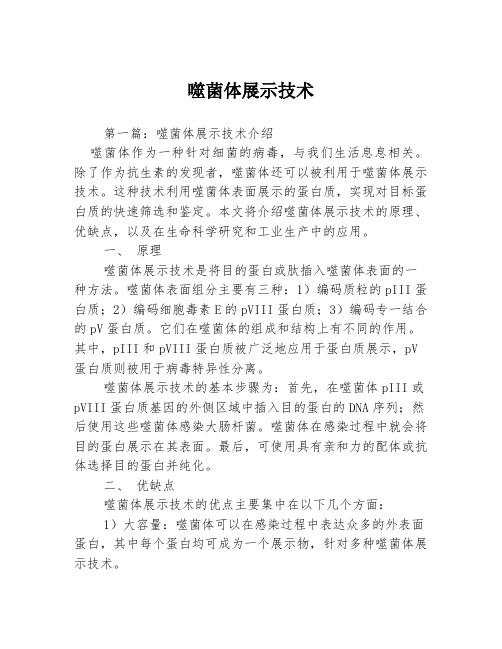
噬菌体展示技术第一篇:噬菌体展示技术介绍噬菌体作为一种针对细菌的病毒,与我们生活息息相关。
除了作为抗生素的发现者,噬菌体还可以被利用于噬菌体展示技术。
这种技术利用噬菌体表面展示的蛋白质,实现对目标蛋白质的快速筛选和鉴定。
本文将介绍噬菌体展示技术的原理、优缺点,以及在生命科学研究和工业生产中的应用。
一、原理噬菌体展示技术是将目的蛋白或肽插入噬菌体表面的一种方法。
噬菌体表面组分主要有三种:1)编码质粒的pIII蛋白质;2)编码细胞毒素E的pVIII蛋白质;3)编码专一结合的pV蛋白质。
它们在噬菌体的组成和结构上有不同的作用。
其中,pIII和pVIII蛋白质被广泛地应用于蛋白质展示,pV 蛋白质则被用于病毒特异性分离。
噬菌体展示技术的基本步骤为:首先,在噬菌体pIII或pVIII蛋白质基因的外侧区域中插入目的蛋白的DNA序列;然后使用这些噬菌体感染大肠杆菌。
噬菌体在感染过程中就会将目的蛋白展示在其表面。
最后,可使用具有亲和力的配体或抗体选择目的蛋白并纯化。
二、优缺点噬菌体展示技术的优点主要集中在以下几个方面:1)大容量:噬菌体可以在感染过程中表达众多的外表面蛋白,其中每个蛋白均可成为一个展示物,针对多种噬菌体展示技术。
2)直接鉴定:在已知多肽的情况下,可以使用特定的抗体直接鉴定噬菌体表面的展示蛋白。
3)高灵敏度:噬菌体展示技术对目标蛋白的识别灵敏,并且可以使用大量病毒颗粒进行检测。
4)高效率:噬菌体展示技术可将展示蛋白直接表达在噬菌体的表面,无需进行分离提纯,从而加快了蛋白纯化过程。
噬菌体展示技术的缺点主要有以下几方面:1)分子大小限制:目前仅适用于直径小于1/3噬菌体直径的蛋白分子。
2)生物安全:组装成噬菌体后,展示蛋白无法及时得到更新,可能会导致噬菌体的生物安全风险。
3)抗原性:由于目的蛋白常常被表达在噬菌体的表面,因此它们可能会被视为异物而引起免疫反应。
三、应用由于噬菌体表面蛋白质的展示,噬菌体展示技术已经被广泛应用于生物医学研究和工业生产中。
噬菌体展示技术的原理和方法
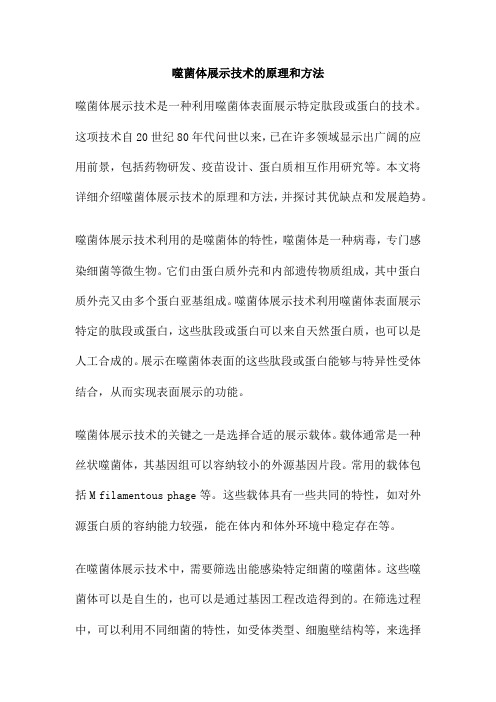
噬菌体展示技术的原理和方法噬菌体展示技术是一种利用噬菌体表面展示特定肽段或蛋白的技术。
这项技术自20世纪80年代问世以来,已在许多领域显示出广阔的应用前景,包括药物研发、疫苗设计、蛋白质相互作用研究等。
本文将详细介绍噬菌体展示技术的原理和方法,并探讨其优缺点和发展趋势。
噬菌体展示技术利用的是噬菌体的特性,噬菌体是一种病毒,专门感染细菌等微生物。
它们由蛋白质外壳和内部遗传物质组成,其中蛋白质外壳又由多个蛋白亚基组成。
噬菌体展示技术利用噬菌体表面展示特定的肽段或蛋白,这些肽段或蛋白可以来自天然蛋白质,也可以是人工合成的。
展示在噬菌体表面的这些肽段或蛋白能够与特异性受体结合,从而实现表面展示的功能。
噬菌体展示技术的关键之一是选择合适的展示载体。
载体通常是一种丝状噬菌体,其基因组可以容纳较小的外源基因片段。
常用的载体包括M filamentous phage等。
这些载体具有一些共同的特性,如对外源蛋白质的容纳能力较强,能在体内和体外环境中稳定存在等。
在噬菌体展示技术中,需要筛选出能感染特定细菌的噬菌体。
这些噬菌体可以是自生的,也可以是通过基因工程改造得到的。
在筛选过程中,可以利用不同细菌的特性,如受体类型、细胞壁结构等,来选择合适的噬菌体。
还需要考虑噬菌体的毒性、繁殖能力等因素。
在噬菌体展示过程中,需要反复感染以积累足够数量的展示肽段或蛋白。
这个过程中,通常需要使用超滤或凝胶过滤等手段对噬菌体进行纯化,以确保得到的展示肽段或蛋白的纯度和浓度。
反复感染的过程不仅可以增加展示肽段或蛋白的数量,还能帮助排除展示过程中可能产生的突变。
克隆选择是噬菌体展示技术的另一个关键步骤。
这个过程中,通过将展示肽段或蛋白与特定配体结合,筛选出能够与配体结合的克隆。
这些克隆可以进一步扩增和纯化,从而获得高亲和力和高特异性的克隆。
噬菌体展示技术的优点在于其能够将蛋白质或多肽特异性与噬菌体的生物学特性相结合,从而实现表面展示的功能。
噬菌体展示筛选抗体技术介绍

探索生物医学中的创新应用
目录
01 噬菌体展示筛选抗 体概述
06 噬菌体展示抗体的 发展前景
02 噬菌体展示技术原 理
03 噬菌体展示抗体筛 选流程
0Hale Waihona Puke 噬菌体展示抗体的 应用案例05 噬菌体展示抗体的 优点与缺点
01 噬菌体展示筛选抗体 概述
噬菌体展示筛选抗体概述
1 噬菌体展示筛选抗体技术介绍
疗效果并降低副作用。
05 噬菌体展示抗体的优 点与缺点
噬菌体展示抗体的优点与缺点
噬菌体展示抗体的优 势
噬菌体展示技术能够快速、 高效地筛选出特异性抗体, 大大缩短了实验周期,提高 了研究效率。
噬菌体展示抗体的局 限性
噬菌体展示技术虽然筛选速 度快,但存在假阳性率高的 问题,需要进一步的验证和 优化。
噬菌体展示筛选抗体技术是一种利用噬菌体表面
噬菌体展示筛选抗体的优势 2 展示特定蛋白质,通过生物淘选方法寻找与目标
噬菌体展示筛选抗体技术具有高度灵活性和多样
抗原特异性结合的抗体的方法。
性,能够快速、高效地筛选到具有高亲和力和特
异性的抗体,为免疫学研究和药物开发提供了重
要工具。 3 噬菌体展示筛选抗体的应用前景
噬菌体展示抗体的优 势
噬菌体展示技术具有高度灵 活性和多样性,可以快速、 大量地筛选出特异性强、亲 和力高的抗体,为生物医学 研究和药物开发提供了重要 工具。
噬菌体展示抗体的应 用前景
噬菌体展示抗体技术在肿瘤 治疗、免疫诊断、疫苗研发 等领域具有广泛应用前景, 有望为人类健康事业做出重 要贡献。
谢谢大家
噬菌体展示筛选抗体技术在疾病诊断、治疗和预
防等方面具有广泛的应用前景,包括癌症治疗、
噬菌体展示技术
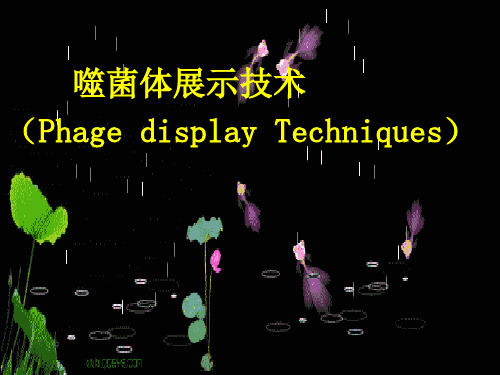
内容
1 2 3
• 噬菌体展示技术简介
• 噬菌体展示技术的过程 • 噬菌体展示技术的应用 • 噬菌体展示技术的展望
4
1
• 噬菌体展示技术简介
噬菌体展示技术是将多肽或蛋白质的编 码基因或目的基因片段克隆入噬菌体外 壳蛋白结构基因的适当位置,在阅读框 正确且不影响其他外壳蛋白正常功能的 情况下,使外源蛋白或多肽与外壳蛋白 融合表达,融合蛋白随子代噬菌体的重 新组装而展示在噬菌体表面。
不可否认,目前噬菌体展示技术尚存在某些不 足,需要改进,如外源性多肽的折叠、库容量 的限制、筛选过程中阳性克隆的丢失及假阳性 克隆的获得等。但随着该技术的不断发展,越 来越多的具有良好生物活性的化合物会被发现 并得以鉴定,为新药的开发不断注入新的活力。 可以预测,功能基因组学、蛋白组学和噬菌体 展示技术三者的融合会不断为药学生物技术创 造新的概念,提供新的策略。基于机器人技术的 高通量筛选系统及其他对策的发展,期待噬菌 体展示技术能在寄生虫病诊断、致病机制研究、 疫苗开发、药物研制领域中开创一片新天地。
coated microtitre wells
Wash to remove unbound phage particles.
Elute bound phage
2.3 Amplify eluted phage
感选
3
• 噬菌体展示技术的应用
3.1 3.2 3.3 3.4 噬菌体抗体库技术 测定抗体的抗原决定簇 筛选酶抑制剂 构建cDNA3.2 测定抗体的 抗原决定簇
3.3 一步确认 确认插入片段种类
4
• 噬菌体展示技术的展望
随着噬菌体展示技术的不断成熟和完善,它 在生物学领域和医学领域取得的成就日益突出 ,尤其是为新药的开发拓宽了道路。运用噬菌 体展示技术筛选功能性的多肽,由此作为多种 人体生长因子的活性模拟表位,或作为受体新 型配体,已经成为当今世界医药领域最热门的 课题之一。通过噬菌体展示技术体外筛选具有 治疗活性的人源的scFv ,则以其分子量小、穿 透力强、易于大量生产等特点展示了极好的应 用前景,从而进一步加快了生物药学的发展进 程。
噬菌体展示
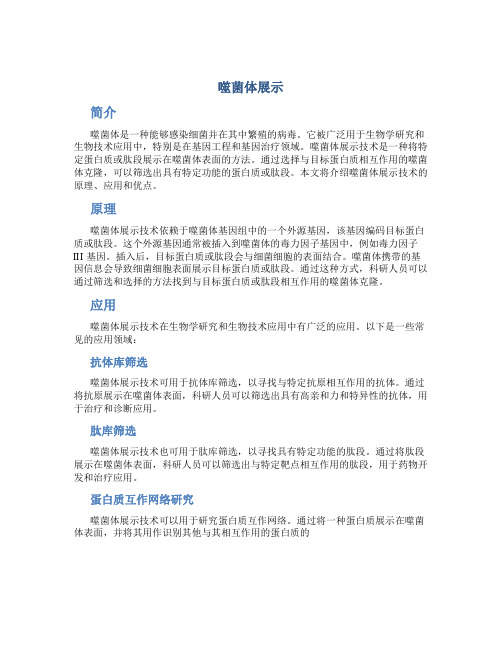
噬菌体展示
简介
噬菌体是一种能够感染细菌并在其中繁殖的病毒。
它被广泛用于生物学研究和生物技术应用中,特别是在基因工程和基因治疗领域。
噬菌体展示技术是一种将特定蛋白质或肽段展示在噬菌体表面的方法。
通过选择与目标蛋白质相互作用的噬菌体克隆,可以筛选出具有特定功能的蛋白质或肽段。
本文将介绍噬菌体展示技术的原理、应用和优点。
原理
噬菌体展示技术依赖于噬菌体基因组中的一个外源基因,该基因编码目标蛋白质或肽段。
这个外源基因通常被插入到噬菌体的毒力因子基因中,例如毒力因子III基因。
插入后,目标蛋白质或肽段会与细菌细胞的表面结合。
噬菌体携带的基因信息会导致细菌细胞表面展示目标蛋白质或肽段。
通过这种方式,科研人员可以通过筛选和选择的方法找到与目标蛋白质或肽段相互作用的噬菌体克隆。
应用
噬菌体展示技术在生物学研究和生物技术应用中有广泛的应用。
以下是一些常见的应用领域:
抗体库筛选
噬菌体展示技术可用于抗体库筛选,以寻找与特定抗原相互作用的抗体。
通过将抗原展示在噬菌体表面,科研人员可以筛选出具有高亲和力和特异性的抗体,用于治疗和诊断应用。
肽库筛选
噬菌体展示技术也可用于肽库筛选,以寻找具有特定功能的肽段。
通过将肽段展示在噬菌体表面,科研人员可以筛选出与特定靶点相互作用的肽段,用于药物开发和治疗应用。
蛋白质互作网络研究
噬菌体展示技术可以用于研究蛋白质互作网络。
通过将一种蛋白质展示在噬菌体表面,并将其用作识别其他与其相互作用的蛋白质的。
2021噬菌体展示技术.完整资料PPT

第五步:扩增—将洗脱的噬菌体扩增 扩增产物进行下一轮筛选
后面的筛选逐步加大筛选压力
多克隆和单克隆噬菌体ELISA
ELISA阳性克隆测序,最终得 到特异性结合的克隆序列
感染 和扩增
E.coli
20
噬菌体展示系统 Phage on display
•噬菌体展示原理 –噬菌体展示定义、分类
–简介噬菌体及淘选过程
15
噬菌体抗体库淘选示意图 液相法
第一步:生物素化抗体与磁珠结合 Bind to Streptavidin coated magnetic bead biotin -antigen
16
第二步:磁珠生物素化抗原复合物与抗体库结合
17
第三步:洗涤—洗去非特异和弱结合的噬菌体
18
第四步:洗脱—将特异性结合的噬菌体洗脱下来
感染后1小时内平均每个细胞分泌1000个噬菌体 Helper phage:提供噬菌体质粒复制、合成ssDNA和病毒包装所需要的所有蛋白和酶。 什么是噬菌体表面展示技术 次要外壳蛋白 pIII 噬菌体质粒-phagemid 噬菌体展示系统 Phage on display G1、G2:甘氨酸片段,在感染过程中,增加各个功能域之间的灵活性 丝状噬菌体展示系统一般是在外壳蛋白pIII或pVIII的N端融合表达外源多肽及蛋白。 406 aa 组成,5个拷贝,位于噬菌体的尾部。 与噬菌体组装终止有关。 与噬菌体组装终止有关。 〔packing signal〕 第五步:扩增—将洗脱的噬菌体扩增 温和噬菌体---M13 Helper phage:提供噬菌体质粒复制、合成ssDNA和病毒包装所需要的所有蛋白和酶。
•噬菌体展示应用 •淘选过程中常见问题及解决方案
21
噬菌体展示的应用
噬菌体抗体库技术
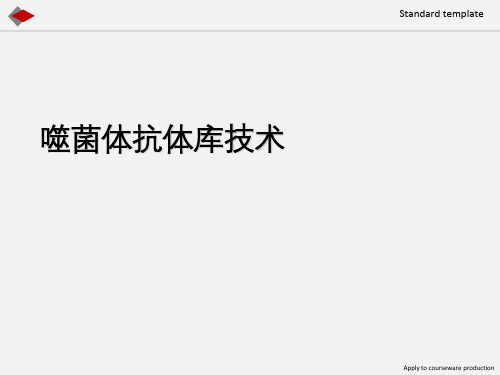
在抗体片段如ScFv和Fab的可变区基因序列的5‘端加入细菌的信号肽
序列,抗体片段即可分泌到(ZHOU)质腔,并在那里完成折叠,成为有功能
的蛋白质分子,
3有效筛选系统的建立
传统的筛选方法使用固相化的纯化抗原,依赖噬菌体颗粒对目的抗原的
亲和力差异来获得较高亲和力的抗体,而目前,可以在体外用完整的固化哺
3.2噬菌体抗体库载体的构建
首先提取细胞的总RNA,经过RTPCR扩增可变区基因
Standard template
酶切轻链PCR产物和表达载体
二者连接,转入感受态细胞中扩增
重链的PCR产物
酶切
成为轻链库
酶切
二者按照一定比例连接
转化入感受态细胞
加入噬菌体
收集噬菌体颗粒
噬菌体总抗体库
Apply to courseware production
简单的PEG沉淀方法就足以将噬菌体与其他所有污染的细胞蛋白分开,
Apply to courseware production
2.2噬菌体展示所使用的衣壳蛋白
Standard template
次要衣壳蛋白pIII
406aa组成,5个拷贝,位于噬菌体的尾部,
由三个功能区组成:
N1穿膜区:作用于E.coli细胞膜上的TolA
有Helperphage,噬菌粒就像质粒
一样进行扩增,
包装后的噬菌体含有两种不同
来源的成分:噬菌体质粒和
Helperphage,
使用野生型辅助噬菌体会导致
噬菌体污染,使得仅有很少部分
子代噬菌体带有抗体片段,
当有噬菌质粒时,由于噬菌质粒
含有野生型M13或者f1复制起
噬菌体展示技术在生物检测上的应用

噬菌体展示技术在生物检测中的应用摘要:噬菌体展示技术(Phage display technology,PDT)是通过将外源基因与噬菌体基因组中编码外壳蛋白的基因融合,在噬菌体侵染宿主细胞后,能够将目的基因编码的多肽展示在噬菌体表面的技术。
噬菌体展示技术已被用于药物开发、肿瘤研究以及免疫学等领域。
本文主要介绍噬菌体展示技术的基本原理以及该技术在真菌毒素、农药等生物检测上的应用。
关键词:噬菌体展示技术;生物检测;真菌毒素;农药Phage Display Technology and Its Application in BiologicalDetectionGuan Pang Academic advisor: Yongheng LiangAbstract:Phage display technology is a technology which fuses exogenous gene and phage gene encoding phage coat protein,which can display the protein encoded by target gene on phage surface after infecting the host cell. Nowadays, phage display technology has been used in the fields of drug development, cancer research and immunology. This paper mainly introduces the basic principle of phage display technology and its application in mycotoxin and pesticide detection.Key words: Phage display technology;biological detection;mycotoxin;pesticide噬菌体展示技术是最早是由美国的Smith GP创建,首次将外源基因插入丝状菌体f1的基因Ⅲ,使目的基因编码的多肽展示在噬菌体表面[1]。
噬菌体展示技术和其通用实验技术简介精编版

相比噬菌体载体噬菌粒具有以下优点:
1.双链DNA既稳定又高产,具有常规质粒的特征; 2.免除了将外缘DNA片段从质粒亚克隆于噬菌体载体这一
繁琐又费时的步骤; 3.由于载体足够小,故可得到长达10kb的外源DNA区段的
单链。
pCANTAB5e噬菌体质粒图谱
1.1噬菌体展示技术的发展
Smith 在 1985 年首次证实外源 DNA 可以插入 丝状噬 菌体基因 III 中,并与 pIII 蛋白融合展示。
Smith GP. Science 1985; 228:1315-7
1985 第一次发表噬菌体展示技术;展示多肽 Smith GP. Science.1985; 228:1315-7 1988 噬菌质粒系统 1990 e two-hybrid’技术 1996 首次体内in vivo 淘选试验 1998 噬菌体展示载体作为基因导入载体 1999 Combination of phage display with high-density arrays 2001 Automated phage display selection
报告人:王东方
噬菌体展示 Phage display
1.什么是噬菌体展示 2.噬菌体展示技术的原理 3. 常用的噬菌体展示系统 4.单链丝状噬体展示在重组抗体制备中的应用 5.菌噬体菌展体示展技示术技在术其应它用与展望
1.什么是噬菌体展示技术?
噬菌体展示技术(Phage Display Techniques ,PDT) 是一项筛选技术,将外源多肽或蛋白与噬菌体的衣壳 蛋白融合表 达,融合蛋白展示在病毒颗粒的表面,而 编码该融合子的 DNA则位于病毒粒子内。使大量多肽 与其DNA编码序列之间、表型与基因型之间建立了直接 联系,使各种靶分子(抗体、酶、细胞表面受体等) 的多肽配体通过淘选得以快速鉴定。
噬菌体展示技术

第二步:磁珠生物素化抗原复合物与抗体库结合
17
第三步:洗涤—洗去非特异和弱结合旳噬菌体
18
第四步:洗脱—将特异性结合旳噬菌体洗脱下来
19
第五步:扩增—将洗脱旳噬菌体扩增 扩增产物进行下一轮筛选
背面旳筛选逐渐加大筛选压力
多克隆和单克隆噬菌体ELISA
ELISA阳性克隆测序,最终得 到特异性结合旳克隆序列
噬菌体展示系统 Phage on display 1
噬菌体展示系统 Phage on display
•噬菌体展示原理 –噬菌体展示定义、分类
–简介噬菌体及淘选过程
•噬菌体展示应用 •淘选过程中常见问题及处理方案
2
什么是噬菌体表面展示技术
Smith在1985年首次证明外源DNA能够插入丝状噬菌体基 因III中,并与pIII蛋白融合展示。
• 有供筛选旳抗生素标识基因。
• Helper phage:提供噬菌体质粒复制、合成ssDNA和 病毒包装所需要旳全部蛋白和酶。
13
筛选旳措施-亲和淘选
直接包被淘选法: 直接将靶分子包被在固相表面 优点:简朴直接。 缺陷:偶尔会造成配体结合位点难以进入 可能是因为分子旳立体封阻 或者是靶分子表面旳部分变性而引起 液相淘选法: 将靶蛋白与噬菌体抗体库先结合,之后再亲和捕获靶分子-噬菌体 复合物。 优点:克服直接包被旳出现旳问题 缺陷:轻易筛到与亲和素(或者链酶亲和素)结合旳克隆。
23
谢谢
24
6. 感染后1小时内平均每个细胞 分泌1000个噬菌体
6
次要外壳蛋白 pIII
1. 406 aa 构成,5个拷贝,位于噬菌 体旳尾部。
2. 由三个功能区构成: • N1 穿膜区:作用于E.coli细胞膜上
噬菌体展示技术的原理及应用
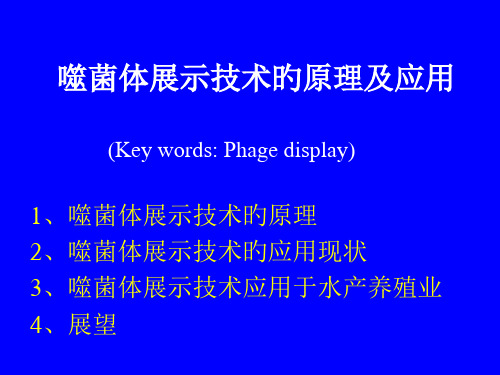
二、噬菌体展示技术旳应用现状
抗体: 抗狂犬病毒旳单链抗体, 抗HIV-1囊膜糖蛋白旳单链抗体,此抗体可专一性杀死被HIV-1感染并体现有gp120旳淋巴细胞, 中和响尾蛇毒素旳单链抗, 等等。
疫苗: 展示在噬菌体表面旳HIV-1 旳gp120-V3 环 可象天然抗原一样引起明显旳免疫应答, 等等。
噬菌体抗体库旳构建
Antibody IgG structure
Antibody IgG structure
C
L
V
L
V
H
C
H
1
V
L
C
L
V
H
C
H
1
C
H
2
C
H
2
C
H
3
C
H
3
Antibody IgG structure
Hinge
(Fab’)2
Fab
Fc
MembraneExtension
Antibody IgG structure
选择措施: 淘选(Panning)而不是 筛选(Screening)
非展示系统 展示系统
Solid phase selection with immunotubes
B
B
B
B
B
B
Immunotubecoated withantigen
诊疗 被动免疫 抗体 蛋白质构造分析 药物导航 蛋白质纯化
Wash to remove unbound phage particles.
Elute bound phage
Amplify eluted phageRepeat selectionAnalyze a) ELISA b) Specificity c) Sequencing d) Affinity e) Activity
- 1、下载文档前请自行甄别文档内容的完整性,平台不提供额外的编辑、内容补充、找答案等附加服务。
- 2、"仅部分预览"的文档,不可在线预览部分如存在完整性等问题,可反馈申请退款(可完整预览的文档不适用该条件!)。
- 3、如文档侵犯您的权益,请联系客服反馈,我们会尽快为您处理(人工客服工作时间:9:00-18:30)。
Antibody Libraries
• Naïve natural libraries: universal
antibody libraries generated from B-cells of nonimmunized donors and eliminate the need to construct new libraries for each antigen.
• Phage Ab Selection Methods & Strategies
• Phage Ab Screening Applications
• In vitro Affinity Maturation
• Expression & Purification
Introduction of Phage Display Technology
• Advantages: ✓ Matured in vivo ✓ Immune libraries can be generated from any animal and even humans: mouse, human, chicken, rabbit, camel… ✓ Any species that have been immunized, infected, or exposed to an antigen. ✓ Useful in analyzing natural humoral responses, for example, in patients
The Ff bacteriophage structure
Introduction of Phage Display Technology
The scheme of phagemid vector
▪ IG region: intergenic region, usually
contains the packing sequence and replication origin of minus and plus strands
• lower affinities than those generated during in vivo affinity maturation.
• to find good antibodies against diverse antigens, these libraries need to be very large.
Antibody Libraries
• Immune libraries: first, immunize
an animal with an antigen and isolate the mRNA from B lymphocytes ( for immunized animals) or peripheral blood B cells (for immunized donors). The mRNA is then reverse transcribed into cDNA, and the variable regions of expressed antibodies are amplified via PCR and cloned into a phage display vector.
• Advantages: ✓ freedom in antigen choice, including self, nonimmunogenic, and
Antibody Libraries
▪ Proteins to be selected are
infused to all five coat proteins, with pIII and pVIII most commonly used.
▪ pIII protein is essential for
infection of bacteria
• Capable of generating antibodies against
Antibody Formats
• The most commonly used format: single-chain variable fragment (scFv) ✓ Simplicity of cloning process ✓ Fast and easy library generation ✓ A high display rate (small protein size ~25 kDa) ✓ Less stable than Fab fragments ✓ Tend to form dimers (can be reduced with linker more than 20 amino acids)
✓ Diabodies are noncovalent dimers of scFvs, which spontaneously form depending on the linker length between VH and VL. Another form of diabodies is two scFvs connected with a short linker.
▪ Helper phage: wild-type pIII
helper phage and special helper phage
▪ Antigen immobilized on magnetic
beads, polystryrene surfaces, or on columns, or is used in solution as biotinylated antigen and later captured by immobilized
▪ Coat protein: PIII (larger protein, less
than 5 copies,) PVIII (more than 5 copies, decreased length)
▪ Amber codon TAG: supE strains
(glutamic acid codon), non-suppressor strains (stop codon)
▪ Protease cleavage site
▪ Promoter
▪ Signal peptides: phage protein
Introduction of Phage Display Technology
▪ Nonlytic filamentous phage is the
most often used for phage display, primarily the M13 and Fd strains.
Antibody Formats
vNAR
• Single domain antibody
✓ VHH: VH domain of camelid antibody, heavy chains only,
✓ IgNAR (new antigen receptor): shark antibody, heavy chains only,
Antibody Formats
• Fab ✓ The light chain (VL-CL) and the Fddomain (VH-CH1) of the heavy chain of an antibody. ✓ During bacterial expression, these two chains are synthesized separately, and secreted into the periplasm where they fold to form heterodimers. ✓ Fab exhibit higher stability than scFvs ✓ Possess better PK and PD qualities than scFvs ✓ Easier to convert into full-length antibodies ✓ Clinical applications: abciximab, lucentis, cimzia.
✓ Unique CDRs • Affibodies • Anticalins • DARPins • Avimers • Affimers • Monobodies
Antibody Formats
• Multivalent fragments
✓ Miniantibodies are scFvs or Fabs connected via a flexible linker to selfassociating structures such as helix bundles or leucine zippers.
• Bypass the use of animal cells for production of antibodies.
• Producing the combinatorial library (ideally with 108 to 109 members) of functional antibodies to generate a larger repertoire of antibodies than those available through conventional hybridoma technology.
Advantages of Phage• DMiosrepelfaficyienftolyrthRanethcrooumgh binant
Antibody Selection •
conventional hybridoma system. Cheaper to produce recombinant
Antibody Phage Display
Meiling Xiong 20180629
